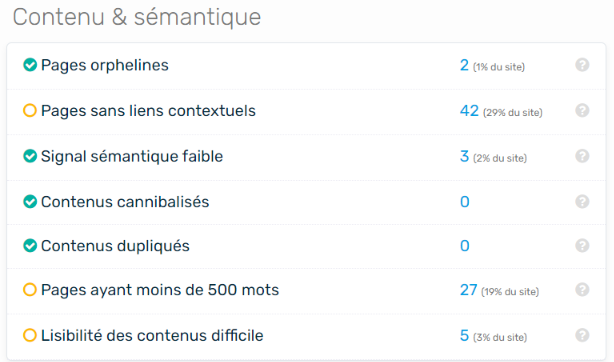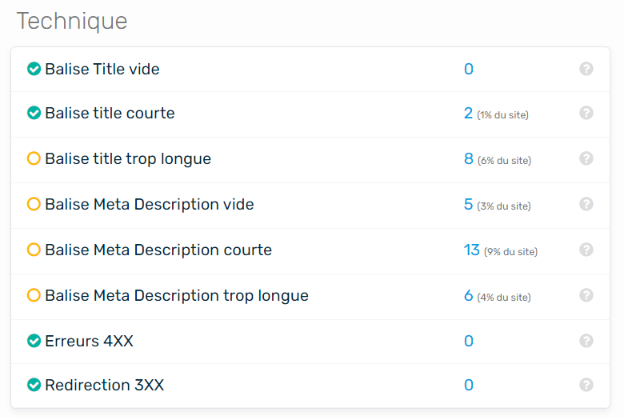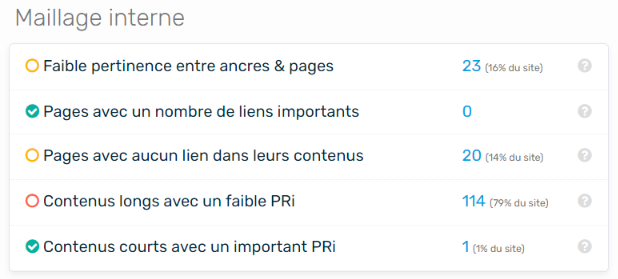Do you want to improve your visibility on the web? Attract organic traffic and make a living from your online activity? Be relevant in the eyes of Google? I invite you to discover without further delay how to perform a semantic SEO audit to improve your performance on the Internet. To make this technical analysis more concrete, I share with you an example of a semantic analysis carried out on our site.
🚀 Express reading: what will you learn in this post?
In this blog post, I will show you how to use SEOQuantum's crawl tool to perform a comprehensive semantic audit of your site. I will analyze the problems encountered and provide you with solutions to optimize the factors that penalize your organic search ranking.
Using a semantic audit example, I propose to discover how to analyze the crucial points that follow:
- analysis of content;
- control of on-page technique;
- verification of linking;
- details of all internal pages;
- overview of the skeleton of the audited site.
❓ What is a semantic audit?
A semantic audit, sometimes called a content audit or editorial audit, allows you to check the relevance of a website and the quality of its content. This in-depth study is therefore essential for improving your organic search ranking and is an integral part of a complete SEO audit.
Performing a semantic analysis means discovering the optimization elements to be applied to your site to make it more visible on Google:
- determine the level of expertise in your field;
- discover the consistency of your pages (keyword clustering);
- understand the relationships between each of your pages (internal linking);
- know the penalizing factors for your organic search ranking;
- plan priority improvements.
If this key element is so important, it is because search engines also carry out a semantic study to analyze the pages published on the Web. In 2011, the update of Google's algorithm, known as Panda, shook up the search results pages. The fight against keyword stuffing has since translated into a new way of considering a text and a site as a whole: the semantic field.
👀 Semantic audit: SEOQuantum example
Do you want to know how to perform a semantic audit in just a few minutes? It's possible with SEOQuantum's semantic crawler tool!
At a glance, you discover the performance score of your site as well as numerous areas for improvement. You can also export the complete crawl and linking data to an Excel workbook to gather all this information in a single document.

In the header of the semantic report, you clearly see the themes on which the site is relevant. You also discover the dominant anchors of your internal links, which is a revealing element of the main topics you address.
Below these first groups of information, you have access to 3 detailed categories of analysis, accompanied by optimization tips. The study focuses on content, on-page technique, and internal linking.
1. Content and semantics
In this section, we analyze the semantic relevance of all the analyzed pages as well as the key factors for your page to be indexed on search engines. To push the analysis on a case-by-case basis, you can then use the SEOQuantum semantic analysis tool.

Orphan pages
Analysis: 2 orphan pages appear in the audit report. This means that they are present in the sitemap.xml file, but they are not linked to any other page by internal links.
Advice: adding links to these URLs will help increase their notoriety.
Pages without contextual links
Analysis: 42 pages are not pointed to by hypertext links contained in the text itself. This is despite the fact that they appear in the sitemap.xml file.
Advice: the same recommendation as for orphan pages, you should add links to these pages to improve their popularity.
Weak semantic signal
Analysis: 3 pages have a weak semantic signal. This means that the theme of the subject addressed could not be clearly identified.
Advice: rework this content by focusing on a particular theme and placing varied expressions that are representative of your main query.
Cannibalized content
Analysis: we do not have any pages affected by a case of SEO cannibalization, which would imply that they compete with each other.
Advice: if this had been the case, it would be necessary to update the content of one of the affected pages to differentiate it from the other.
Duplicate content
Analysis: no page contains duplicate content.
Advice: if this were the case, the texts would need to be rewritten to avoid being penalized by search algorithms.
Pages with less than 500 words
Analysis: 27 pages with content less than 500 words were identified during the semantic audit.
Advice: increasing the length of the content will allow for better detailing of the subject and, thus, improve its chances of appearing in Google's top results.
Difficult content readability
Analysis: according to the Flesch-Kincaid readability test, 5 contents are considered difficult to read.
Advice: shortening sentences, simplifying vocabulary, broadening the lexical field, or using more transition words are good ways to facilitate reading.
2. On-page technique
In this part of the semantic analysis report, we check the technical elements present on each of the studied pages. To learn more about ranking factors, I invite you to read the following article: Checklist for on-page and off-page SEO (technique, content, and external links).

Title tag
Analysis: all analyzed URLs contain a title tag. However, 2 SEO titles are too short and 8 are too long.
Advice: this element is very important in terms of SEO. Each page must be filled in with a unique title (H) of a length between 50 and 60 characters (maximum 512 pixels).
Meta description tag
Analysis: 5 meta descriptions are empty, 13 are too short, and 6 are too long.
Advice: the indirect influence of this tag on SEO is significant. Indeed, it is a key factor in improving the click-through rate (CTR). Ideally, it should contain between 150 and 160 characters (maximum 920 pixels).
4XX errors
Analysis: all pages were accessible during the semantic crawl.
Advice: if you encounter a 4XX error, you should check the accessibility of the page.
3XX redirects
Analysis: the semantic audit did not reveal any 3XX redirects.
Advice: a redirect causes a loss of SEO juice. Be sure to avoid them as much as possible!
3. Internal linking
The connections between all the pages of your site are crucial for your organic search ranking. Creating internal links is therefore essential to provide complete information to your reader and help indexing robots crawl your entire site. Let's look at the measures displayed in the semantic audit example conducted for the writing of this article.

Low relevance between anchors and pages
Analysis: 23 link anchors do not match the subject addressed in the content of the targeted pages.
Advice: for good internal linking, anchors must reveal the theme of the targeted URL. Be sure to correct those that are not well optimized.
Pages with a significant number of links
Analysis: we do not have any pages containing more than 200 internal links.
Advice: a simple page is favored by users and search engines. If you have too many links, you can simply remove some of them.
Pages with no links in their content
Analysis: 20 contents without internal links were found during the semantic audit.
Advice: according to the reasonable surfer theory, internal linking represents the skeleton of your website. Do not hesitate to add some links to your pages to refine your area of expertise.
Long content with low PRi
Analysis: 114 long contents (more than 500 words) have a low Internal PageRank (PRi) (less than 19).
Advice: create more internal links pointing to these contents.
Short content with high PRi
Analysis: one short text (less than 500 words) has a too high Internal PageRank (greater than 38).
Advice: you could either add textual content to this page or deindex it.
Thanks to SEOQuantum's tool, you have a comprehensive analysis of your website's semantics in just a few minutes. You can thus discover on which pages you should consider making corrections and know the priority areas for improvement for optimizing your search engine ranking.
And you? What tools do you have at your disposal to analyze the semantic field of your site? Do you think there are other elements to study to define the semantic quality of your domain?
Now that you know how to perform a comprehensive semantic audit, I invite you to discover our tool to improve the SEO ROI of your actions and outperform your competitors on the SERP. You can enjoy a free trial for 14 days, so there's no reason not to try it!
Need to go further?
If you need to delve deeper into the topic, the editorial team recommends the following 5 contents:

